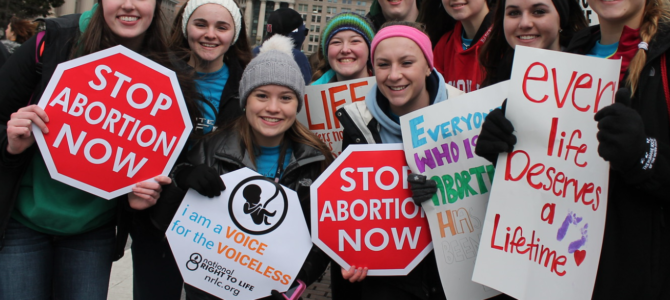
As the Supreme Court begins its latest term, cultural debates over abortion rights versus the right to life are raging once again. It’s all the more fiery because the high court decided last week to take up an abortion-related case out of Louisiana, and the ideological balance of the nine justices has shifted since it last considered the issue.
In recent years, abortion rates nationwide continue to decline, hitting new lows with every updated report. Michael New, a political science Ph.D. with degrees in statistics, stated recently why this heartens pro-life advocates. “The fact that a higher percentage of unintended pregnancies are being carried to term shows pro-life efforts have been effective,” he wrote.
While this multi-faceted movement welcomes legal and cultural advances in the states, the other side has also mobilized this year. New laws that passed this spring in New York and Illinois explicitly protect abortion up to the point of birth — so-called birth day abortions. Coordinated by Emily’s List, Planned Parenthood, and other pro-abortion groups, the national legislative campaign attempted similar efforts that failed in other states and will likely be re-attempted this coming spring.
This weekend, as the 14th annual Values Voter Summit brings together thousands of conservative activists, reversing these late-term abortion laws will be a significant focus. In addition to President Donald Trump, speakers include abortion survivor Melissa Ohden, stalwart pro-life leader Rep. Steve Scalise, R-La., and Democratic Louisiana state Rep. Katrina Jackson, who authored the law being challenged at the Supreme Court.
It’s as if both sides in the debate are preparing for Roe v. Wade to be overturned, which would return abortion policies to the purview of state legislatures. Of course, with approximately 12 months until a presidential election, Congress can be expected to advance few bipartisan measures on life issues — or any controversial policies at all.
The real action is at the grassroots level. Education, mobilization, and advocacy may begin small but can add up to significant progress. Leading pro-life and child welfare groups have created tools and opportunities for advocates to grow in knowledge of these difficult issues, investigate what resources are available locally, and take practical steps to protect vulnerable lives. Here are seven online resources to help pro-life advocates stay informed and get involved in the movement.
1. Where Does My State Stand on Life?
Following the wave of pro-abortion legislative activity this spring, state and federal efforts have focused on enacting basic protections for born-alive abortion survivors. These just-born infants were supposedly protected by a 2002 law, yet that legislation specified no penalties for providers, and its restrictions are often ignored (note the horrific crimes of abortionist Kermit Gosnell).
State legislators have taken up this cause, a movement legislative specialists at Family Research Council have tracked in an online tool that launched this week. With a particular focus on later-term procedures, it reveals which states have the strongest pro-life protections. Legal advocacy group Americans United for Life offers its own national map with comprehensive policy details.
2. Know Where Care Is Provided
Despite its controversies, Planned Parenthood holds a 52 percent favorability rating from the general American populace, according to an NBC/WSJ poll released in August. However, pro-life advocates referring friends or family to a provider are likely to desire better alternatives.
In recent years, a coalition of women’s health groups including Care Net, Susan B. Anthony List, and the Pregnant on Campus Initiative launched an interactive map tool called GetYourCare.org. It lists thousands of low-cost, federally qualified health centers and rural health centers that provide life-affirming comprehensive care.
3. Are Local Clinics Up to Code?
On a related note, abortion facilities are not known for transparent informed-consent policies, including disclosing past health and safety violations. One website seeks to remedy this lack of information.
CheckMyClinic.org compiles Department of State Health reports for every U.S. abortion facility. It lists the unique abortion-related laws for each state, alongside the results of official state inspections of local clinics — often acquired through Freedom of Information Act requests.
4. Is There a ‘Safe Haven’ Nearby?
On June 6, 2019, in a rural city outside Atlanta, Georgia, a family found an abandoned newborn left in a plastic bag and called the police. After being taken to a hospital, she is now doing well. Yet the incident shocked many people because, like all U.S. states, Georgia has enacted a Safe Haven law.
According to Safe Haven laws, a mother can leave her newborn child in the care of state authorities, with no questions asked and with no penalties. Usually any hospital or child welfare agency serves as a drop-off location, though specifics differ by state. The National Safe Haven Alliance reports that since 1999, these laws have saved more than 4,000 lives.
5. Go Beyond Policies and Information to Meet Real People
Hundreds of thousands have been inspired by “Unplanned,” the feature film released in March dramatizing Abby Johnson’s pro-life journey. For years, a group of people maintained a peaceful, prayerful presence in front of the Planned Parenthood facility in central Texas where she was the director. When Johnson faced a crisis of conscience, she ultimately ran to them.
That effort has now expanded globally. Currently, 40 Days for Life is mobilizing its latest campaign of people who stand, pray, and offer help in front of abortion facilities. The ecumenical faith-based group reports people in 500-plus cities and more than 30 countries are participating this fall.
6. Does My Table Have Room for Another Person?
An oft-heard pro-choice criticism is that pro-life advocates have no interest in vulnerable lives past the point of birth. Any honest analysis of the movement would find this is a shortsighted assessment. Still, there is room for all Americans to understand and better engage with child welfare — including, for some, foster care or adoption.
When a birth mother decides to allow another couple to adopt her child, the U.S. child welfare system becomes involved. It’s a complex web of adoption agencies, social workers, sacrificial foster households, and countless advocacy groups seeking to help children. To be equipped and find local resources, the nonprofit coalition Christian Alliance for Orphans provides helpful steps to begin.
7. Understand the Facts on Complex Issues
An understanding of the value of human life will lead advocates into a host of intricate issues related to abortion and pregnancy care. Is there an ethical response to a poor prenatal diagnosis? What are all the government funding sources of abortion providers? Does fetal stem cell research matter?
For more than four decades since Roe v. Wade, experts in medical science, sociology, and psychology have grappled with these and other thorny questions. Many such scholars have published their work at the Charlotte Lozier Institute.
This research institute offers a variety of helpful materials, from one-page fact sheets to extensive peer-reviewed journal articles. Knowledge, after all, is power, especially when linked with action.









